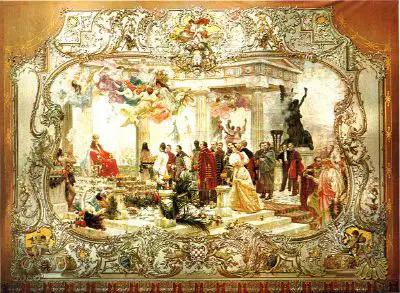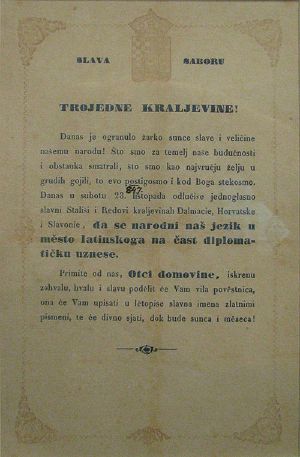Illyrian Movement

Illyrian movement also Croatian national revival (Hrvatski narodni preporod), was a nationalistic campaign initiated by a group of young Croatian intellectuals during the first half of nineteenth century, during the years of 1835-1849 (there is some disagreement regarding the official dates). This movement aimed to create a Croatian national establishment under Austro-Hungarian rule through linguistic and ethnic unity among South Slavs. The various countries of the Balkans, after centuries of domination by the Ottoman Empire or in Croatiaâs case, by the Habsburgs were awakening to the spirit of nationalism that was sweeping through Europe in the wake of the French Revolution. Croatians recalled that, prior to their union with Hungary in 1102, they had enjoyed freedom. After two smaller principalities united in 925 C.E., the kingdom of Croatia existed until it united with Hungary in 1102 C.E. Some distinctive Croatian institutions, including its ancient Assembly of Nobles, remained. In 1527, Croatia became part of the Empire of the Habsburgs but parts fell within the Ottoman Empire. Later, after the collapse of Yugoslavia some Croatians would want to regain territory in Bosnia that had once formed part of a Greater Yugoslavia. They aspired to be a separate, independent nation defined by its own distinctive language and culture.
Perhaps the most significant aspect of this national revival was that it was inclusive of those who lived in what was regarded as the Croatian space in terms of their ethnicity and religion, since language was used to define membership. During World War II, however, non-Croatians fared badly and as a puppet-regime of the Third Reich Croatia was the first to declare itself Jew-free. True unity requires a spiritual basis and can not be generated by cultural mechanism. Unless this is accompanied by inner change, the product will be superficial.
Context of the Movement
In nineteenth-century Europe, liberalism and nationalism were ideologies which came to the forefront of political culture. In Eastern Europe, where the Habsburg Empire had long asserted control over a variety of ethnic and cultural groups, nationalism appeared in a standard format. The beginning of the nineteenth century, "was the period when the smaller, mostly Slavic nationalities of the empireâCzechs, Slovaks, Slovenes, Croats, Serbs, Ukrainians, and the Latin Romaniansâremembered their historical traditions, revived their native tongues as literary languages, reappropriated their traditions and folklore, in short reasserted their existence as nations."[1] This revival of national heritage encompasses the Illyrian Movement in Croatia. In 1813, the bishop of Zagreb Maksimilijan Vrhovac issued a plea for the collection of "national treasures" (Poziv na sve duhovne pastire svoje biskupije), thereby heralding the national revival movement.
Beginnings
Just as Croatia felt nationalistic stirrings at this time, so did its larger neighbors, Hungary and Austria. Croats were uneasy with rising Hungarian nationalism, which pursued reduction of the Croatian autonomy and increased Magyarization. In order to preserve their autonomy, Croats pursued a deepening of their culture and a revival of their heritage.
In the beginning of the 1830s, a group of young Croatian writers gathered in Zagreb and established a movement for national renewal and unity of all South Slavs within the Habsburg Monarchy. The city of Zagreb had become an important center of political, economic, and cultural activity, so it was the center of the movement. Count Janko DraÅ¡koviÄ published his Dissertation in 1832, a pamphlet that later came to be considered the political, economic, social and cultural program of the movement, as it promoted the native language as official, more autonomy from central government, and better education and enlightenment for the common people.
The most important focus of Illyrians was the establishment of standard language as a counter-weight to Hungarian, and the promotion of Croatian written literature and official culture. Ljudevit Gaj was instrumental in providing the foundation for the flourishing of the Croatian literature. Gaj was in fact the leader of the movement as a whole in the beginning for eight or nine years, at which point the leadership changed hands. Gaj was largely responsible for writing the Croatian orthography and grammar (Kratka osnova horvatsko-slavenskog pravopisanja â Brief basics of the Croatian-Slavonic orthography), which was necessary before a literary movement would be successful.
The choice of the name "Illyrian"
The "Illyrian" name was chosen instead of "Slavic," because of the theory that the local population had an Illyrian origin.
Choosing "Illyrian" as their title was a symbolic move on the part of movement members and leadership, an attempt to bring the history of the Croatian people to the forefront. It is somewhat comparable to the French recalling the Gauls.
At the time, Croats were generally considered a Slavic people on the basis of Croatian being a Slavic language, and available genetic data indicated that they were also ethnically Slavic, so this use of "Illyrian" was generally understood to have been wishful thinking. Yet, two centuries later, genetic studies showed that there could actually have been some basis to this reasoning, because the people of Croatia today seem to have a lot of genetic material consistent with the indigenous population from the time of the Migrations Period.
Progress
The most influential writers within the movement were Ivan MažuraniÄ and Petar PreradoviÄ.[2] MažuraniÄ contributed his epic Smrt Smail-age ÄengiÄa during this time, and PreradoviÄ published love lyrics.
Other notable literary contributions were made by Antun MihanoviÄ (notably Horvatska Domovina which later became Our Beautiful Homeland), Stanko Vraz (satiric lyrics), Ljudevit VukotinoviÄ (romantic lyrics), Dimitrija Demeter (prose, notably GrobniÄko polje, and drama), Ivan KukuljeviÄ Sakcinski (prose), Antun NemÄiÄ (prose and itineraries). There was also the first notable itinerary Pogled u Bosnu by Matija MažuraniÄ.
After the government allowed the publishing of newspapers in Croatian in 1834, the Illyrians issued the first Croatian newspaper, "Novine hrvatsko-slavonsko-dalmatinske," in 1835, establishing Croatian journalism. The paper was edited by Ljudevit Gaj and it also had a literary magazine "Danica" attached, both of which printed in Gaj's "National print" (Narodna tiskara). These literary successes "ultimately won intellectual, linguistic, and educational...independence for Croatia."[2]
In 1836, the papers were renamed to use the Illyrian name (Ilirske novine, Danica ilirska). In 1838, Janko DraÅ¡koviÄ helped found a reading room in Zagreb which served as a meeting place for the first "Illyrians."
In another cultural success, in 1846 the composer Vatroslav Lisinski wrote the first opera in Croatian, "Ljubav i zloba" (Love and malice).
Speaking in front of the Sabor on October 23, 1847, Ivan KukuljeviÄ Sakcinski advocated Croatian as the official language instead of Latin and the deputies subsequently voted unanimously in favor of said proposition.
The Illyrian movement, while concentrating on Croatian lands, was quite nationally inclusive, as it included many non-Croats. For example, Petar PreradoviÄ was an ethnic Serb, as was Josif Runjanin, Stanko Vraz was an ethnic Slovene, and Dimitrija Demetar was an ethnic Greek or Aromanian.
Struggles
In 1840, the Illyrian movement suffered an internal setback when Stanko Vraz, Joakim Rakovac and Ljudevit VukotinoviÄ split off from the movement due to creative differences in poetry. In 1842 they started publishing their own literary newspaper named Kolo.
More importantly, the movement was not well received by Hungarians and pro-Hungarian nobility. In 1843, the use of the Illyrian name was banned. Struggles in Croatian Sabor were so harsh that they caused unrest on Zagreb streets. On July 29, 1845, violent conflict causing bloodshed took place on Marko's square, later known as "July victims." Even still, Hungarian officials were unable to crush the movement.
The movement practically ceased to exist due to the Revolutions of 1848. In 1849, the Emperor Francis Joseph imposed a new constitution, all political dissent was censored, and the Danica went out of print.
Aftermath
The movement's plea for unity among the Slavs, particularly South Slavs, also found supporters among prominent Serbs of the time, most notably Vuk StefanoviÄ KaradžiÄ, the reformer of Serbian language. Ljudevit Gaj had, in fact, appealed to Serbia (along with Dalmatia and Russia) for moral and financial support given their ethnic and cultural connections.
In 1850, a small group of Illyrians and Serbian representatives signed the "Vienna agreement" which in effect proclaimed southern Shtokavian dialect to be the standard, common language of Serbs and Croats, with Serbian Cyrillic and Croatian as equal letters. The agreement was the basis of subsequent formation of Serbo-Croatian language and helped to solidify the linguistic progress of those two cultures.
Assessment and criticism
Illyrian movement was the first and most prominent Pan-Slavic movement in Croatian history.
The Illyrian movement was successful in its goals for culture, probably because there was an historical foundation on which it could build. "Where there was no precedent for nineteenth-century concepts like Czechoslovak or Illyrian nationhood these projects failed. Nationalism took hold insofar as it built on existing realities, historical, linguistic or social."[3] The period of the Illyrian movement is today referred to as the "Croatian national revival."
The movement formed the basis for a common Serbo-Croatian language, and it fostered support in Croatia for the later creation of Kingdom of Serbs, Croats and Slovenes in 1918. However, in its ultimate goals of creating an Illyrian state, the movement failed.
Notes
- â Jonathan Sperber, The European Revolutions, 1848-1851 (New York: Cambridge University Press, 2005, ISBN 9780521385268), 99.
- â 2.0 2.1 Francis H. Eterovich, and Christopher Spalatin (eds.), Croatia: Land, People, Culture (Toronto: University of Toronto Press, 1970, ISBN 978-1487598419).
- â Charles W. Ingrao, The Habsburg Monarchy 1618-1815 (Cambridge: Cambridge University Press, 2000, ISBN 9780521380096), 110.
ReferencesISBN links support NWE through referral fees
- DespalatoviÄ, Elinor Murray. Ljudevit Gaj and the Illyrian Movement. East European monographs, no. 12. Boulder, Colorado: East European Quarterly, 1975. ISBN 9780914710059
- Eterovich, Francis H., and Christopher Spalatin (eds.). Croatia: Land, People, Culture. Toronto: University of Toronto Press, 1970. ISBN 978-1487598419
- Gaži, Stephen. A History of Croatia. New York: Philosophical Library, 1973. ISBN 9780802221087
- Ingrao, Charles W. The Habsburg Monarchy 1618-1815. Cambridge: Cambridge University Press, 2000. ISBN 9780521380096
- Sperber, Jonathan. The European Revolutions, 1848-1851. New York: Cambridge University Press, 2005. ISBN 9780521385268
- Tanner, Marcus. Croatia A Nation Forged in War. New Haven, CT: Yale University Press, 1997. ISBN 9780300069334
External links
All links retrieved June 12, 2025.
- The Illyrian movement Encyclopedia of Romantic Nationalism in Europe
- The Illyrian movement in Bulgaria SESDiva
- History of the Kingdom of Croatia. Part III ~ Exploring the Monarchs of Europe
Credits
New World Encyclopedia writers and editors rewrote and completed the Wikipedia article in accordance with New World Encyclopedia standards. This article abides by terms of the Creative Commons CC-by-sa 3.0 License (CC-by-sa), which may be used and disseminated with proper attribution. Credit is due under the terms of this license that can reference both the New World Encyclopedia contributors and the selfless volunteer contributors of the Wikimedia Foundation. To cite this article click here for a list of acceptable citing formats.The history of earlier contributions by wikipedians is accessible to researchers here:
The history of this article since it was imported to New World Encyclopedia:
Note: Some restrictions may apply to use of individual images which are separately licensed.
